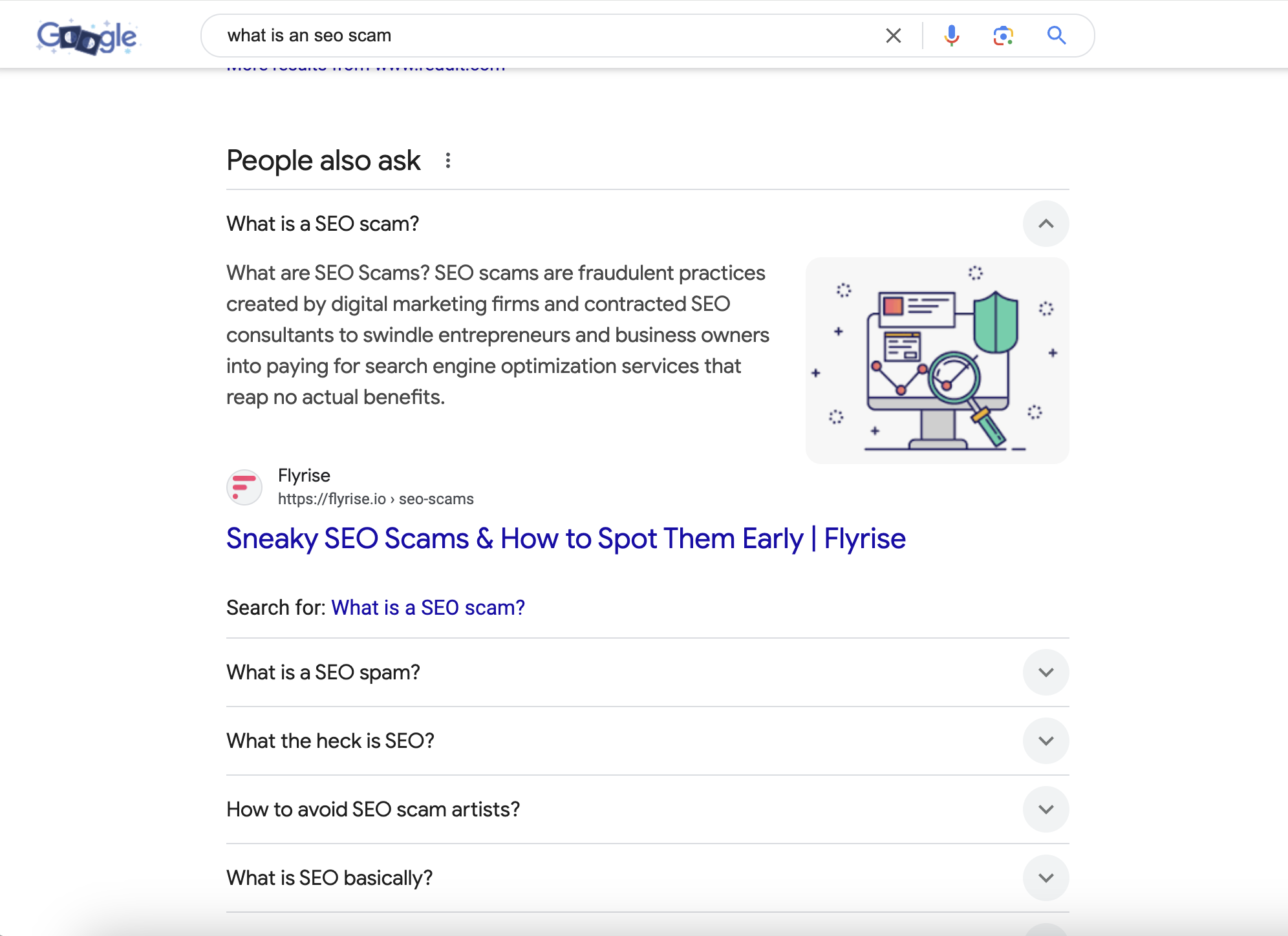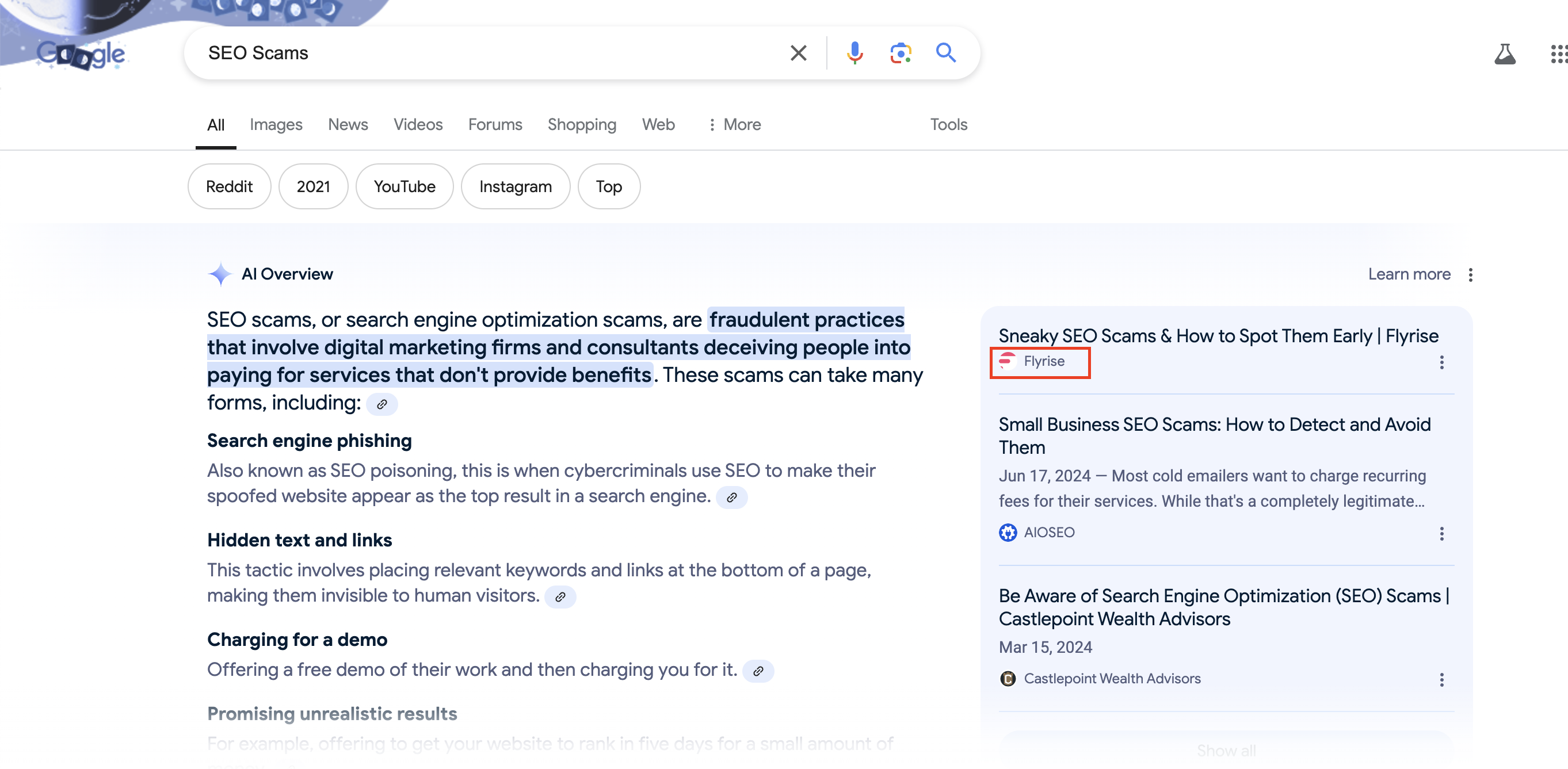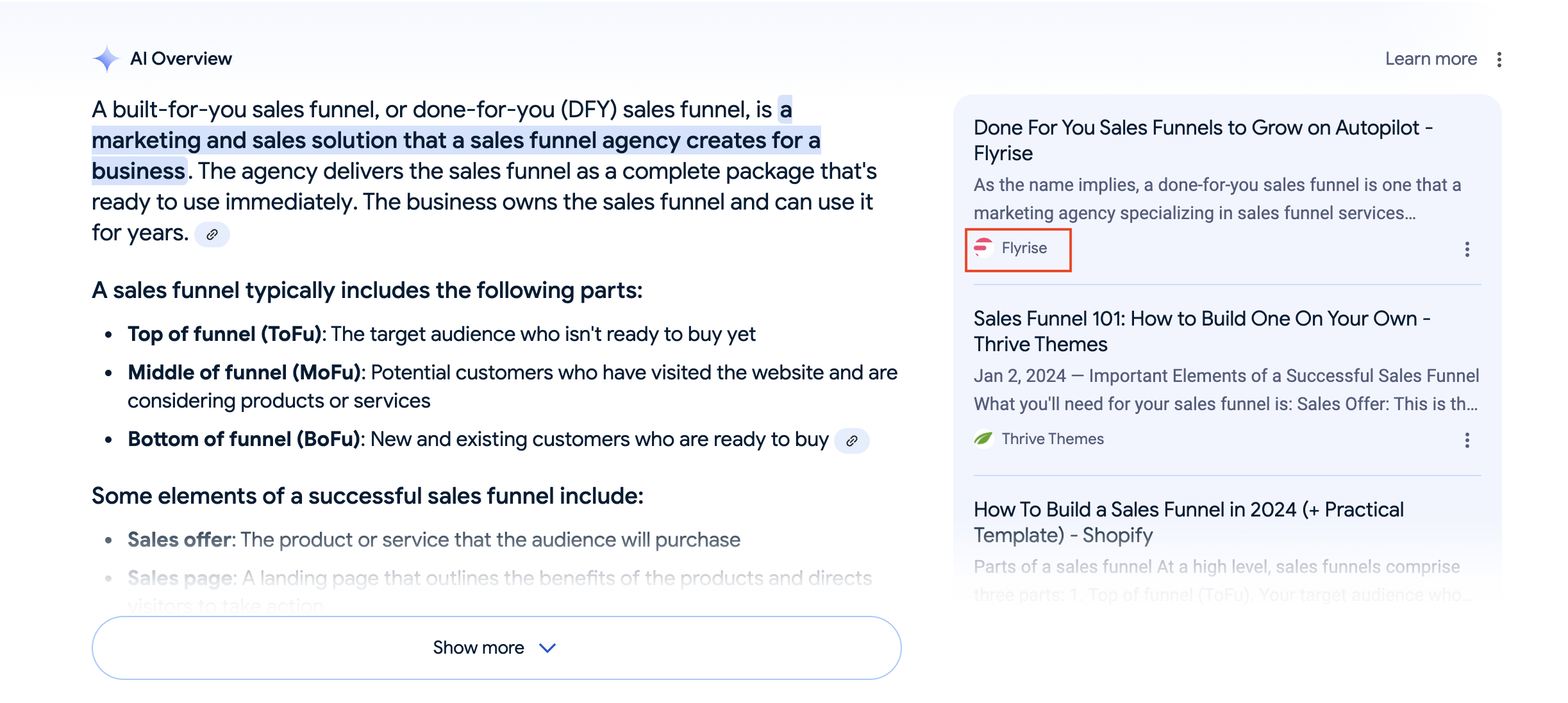Imagine this: your potential customer pulls out their phone and says, “Hey Google, where’s the best local bakery?” Within seconds, Google serves up an answer—without them even clicking a link. If your business isn’t showing up in that result, you’ve just missed an opportunity to get noticed. Welcome to the world of Answer Engine Optimization (AEO).
More than 12.3% of search queries now trigger featured snippets, the answers you see at the top of search results. And with voice search growing rapidly— at least 27% of the global online population is using voice search on mobile—it’s clear that people want fast, direct answers. If your business isn’t optimized for these answer engines, you’re missing out on a huge chunk of potential traffic.
But here’s the key: AEO isn’t a replacement for traditional SEO—at least not yet. It works hand-in-hand with your tried-and-true strategies to give you the best shot at standing out in search results.
In this guide, we’re going to break down AEO—what it is, why it’s crucial for your business, and how to blend it with your current SEO efforts to secure prime real estate in those coveted zero-click results. Whether you’re a small business owner aiming to capture local traffic or a marketing leader looking to stay ahead, Answer Engine Optimization is your ticket to being the go-to source for your customers’ most pressing questions.
Answer Engine Optimization: The Future of SEO
If the last decade was all about getting to page one of Google, the next decade will be about answering questions before users even finish asking them. That’s the magic of Answer Engine Optimization (AEO)—it’s not just about being seen; it’s about being the answer they’re looking for.
AEO goes beyond traditional SEO by focusing on delivering direct answers through featured snippets, knowledge panels, and voice search results. It’s about catering to search engines that have become less like directories and more like digital butlers, anticipating and serving up exactly what users need in real time.
And those answer engines—Google, Siri, Alexa—they’re all hungry for concise, well-structured content. With AEO, your content doesn’t just have a chance to rank; it has the potential to secure that prized “zero-click” spot, where users find answers instantly without needing to click through to a website. It’s the digital equivalent of having a billboard on the busiest highway, except this one answers your customer’s questions on the spot.
But AEO doesn’t operate in a vacuum. It complements traditional SEO like peanut butter compliments jelly. While SEO lays the groundwork by optimizing keywords, backlinks, and site structure, AEO takes that foundation and transforms it for the answer-driven world. Together, they cover both the search engine basics and the evolving needs of users who expect instant, accurate answers—and that’s a trend that’s only going to grow.
So, as you think about where your business fits into the future of SEO, consider this: if you want to stay relevant, Answer Engine Optimization isn’t just an option. It’s the evolution of search that ensures your content isn’t just indexed but is also in the spotlight, answering the questions that matter most.

What is Answer Engine Optimization (AEO)?
Answer Engine Optimization isn’t just about ranking—it’s about becoming the answer. While traditional SEO strategies aim to increase visibility across a range of search results, AEO zeroes in on delivering specific answers to question-based queries. It’s the force behind those featured snippets and voice search results that give users immediate, bite-sized information.
With the rise of conversational queries through voice assistants like Alexa, Siri, and Google Assistant, AEO is becoming essential. Unlike SEO, which spreads a wide net, AEO focuses on structuring content to address the precise questions people ask, from “What’s the quickest way to cook pasta?” to “How do I clean leather shoes?”
The goal of AEO is to optimize for direct answers, often presented in structured formats like lists, tables, and quick summaries. These formats don’t just help answer engines quickly pull relevant content—they also position your business as a trusted source of information that can cater to on-the-go searches, especially on mobile. With AEO, it’s about being ready when the question is asked, and that’s a level of optimization that can set you apart in today’s answer-driven world.
AEO SEO: How Answer Engine Optimization Works Alongside Traditional SEO
Think of Answer Engine Optimization (AEO) as the high-energy sidekick to traditional SEO. While SEO is busy setting up shop—optimizing keywords, building backlinks, and making your site easy to find—AEO swoops in to make sure you’re the star of the show when it comes to quick answers and immediate results.
The magic happens when these two work together. SEO gives you the foundation, making sure you’re visible and credible. AEO, on the other hand, steps in to structure that content in a way that’s ready for quick answers. Think of it as giving your content a double boost—SEO gets you on the search engine’s radar, and AEO puts you in the spotlight as the direct answer to a user’s question.
In fact, for high-traffic keywords, pages that secured Featured Snippets saw a CTR increase of over 114% compared to pages ranking in the #1 position alone. That’s the power of having your content both optimized and answer-ready. When users see your content right at the top, ready with a concise answer, they’re more likely to engage with it than with any of the other links further down the page.
Ultimately, AEO doesn’t replace traditional SEO but complements it. It allows businesses to cover both the broad visibility that SEO provides and the precise answers that AEO targets, resulting in a well-rounded strategy that’s ready for whatever search engines (and users) throw at it.
Optimizing for User Intent: The Key to AEO Success
In the world of Answer Engine Optimization (AEO), understanding user intent is like having the secret recipe for an unforgettable dish. It’s not just about the keywords users are typing in; it’s about figuring out what they actually want—and giving it to them, fast.
When it comes to user intent, not all questions are created equal. Sometimes, users have explicit intent—they’re looking for one clear, precise answer. “How tall is the Eiffel Tower?” or “What’s the capital of Australia?” These users want a quick, factual response, no frills attached.
Then there’s fractured intent, where users might not even know exactly what they want, and they’re open to exploring a range of answers. Think about queries like “best coffee shop drinks” or “ways to save money on travel.” These users are open to suggestions and possibilities, so they’re more likely to click around and explore.
To truly excel in AEO, your content needs to align with both types of intent. Here’s how to make sure your content hits the mark:
Best Practices for Optimizing for User Intent:
- Use FAQs: For quick answers and explicit intent, FAQs are your best friend. They allow you to serve up bite-sized responses that answer specific questions directly, perfect for capturing zero-click results.
- Structure with Tables and Lists: When tackling fractured intent, use tables, lists, and bullet points. These are scannable and offer users multiple options at a glance—exactly what they’re after when their intent isn’t as clear-cut.
- Offer Related Links or Suggestions: For those with fractured intent, provide links to related content or additional resources. This helps guide their journey and keeps them on your site longer.
- Keep it Concise and Clear: Whether you’re dealing with explicit or fractured intent, clarity is king. Stick to short sentences and simple language so users can quickly get what they need without wading through fluff.
- Leverage Structured Data: Using structured data, like FAQ schema or How-To schema, boosts your chances of capturing those featured snippets by making it easy for search engines to read your content.
By mastering user intent, you’re not just answering questions—you’re making your content indispensable. And when your answers hit the mark, you’re not only winning over users but also catching the eye of search engines. It’s the ultimate win-win.
Structured Data: The Power Behind Answer Engines
If Answer Engine Optimization is the art of becoming the answer, then structured data is the secret sauce that makes it all possible. Think of structured data as the language that lets your content speak directly to search engines, telling them exactly how to present your answers. By organizing your information in a way that search engines can easily digest, you increase your chances of landing in featured snippets and knowledge panels—the prime spots for direct answers.
Structured data does more than just make your content readable; it enhances your visibility. With 22.67% of comparison keywords and 17.72% of preposition keywords triggering featured snippets, having well-structured data can be the edge you need to secure these highly visible answer boxes.
So, how can you use structured data to power up your AEO? Here are a few key strategies:
Best Practices for Using Structured Data:
- Implement FAQ Schema: Got a list of frequently asked questions? The FAQ schema lets search engines know you have concise, direct answers to common queries. This not only helps with AEO but can also improve your chances of appearing in People Also Ask (PAA) boxes.
- Use How-To Schema for Step-by-Step Guides: If your content includes instructions or processes, How-To schema is your go-to. It breaks down complex information into scannable steps, making it easier for search engines to present your content as a featured snippet.
- Optimize with Q&A Schema: For forums or community-driven content, Q&A schema can help organize responses to user questions. This is especially useful for capturing those zero-click results where users want the answer right away.
- Utilize Lists and Tables for Comparison Content: When you’re dealing with comparison or process-driven content, structured formats like tables or lists can increase your chances of capturing featured snippets. These formats are easier for search engines to read and often favored for providing direct answers.
Structured data might seem technical, but it’s essentially about packaging your content in a way that speaks search engine fluently. And when your content is optimized to be both user-friendly and search engine-ready, you’re not just in the game—you’re leading it. By leveraging these structured data types, you’re making it easier for search engines to recognize your content as the best answer, ensuring you’re right where users need you to be.

Voice Search Optimization: How AEO Captures Voice Queries
Voice search is more than just a futuristic feature—it’s now a major player in how people find answers online. Even back in 2016, 20% of mobile searches were voice-based, and the numbers have only grown since. With more devices like smartphones, smart speakers, and even cars enabling voice search, optimizing for it is now crucial for any AEO strategy. This isn’t about just being found; it’s about being heard in a world where people ask their devices to do everything from ordering pizza to finding the best nearby coffee shop.
The rise of natural language processing (NLP) has transformed how search engines understand and respond to voice queries. Unlike traditional searches, voice searches tend to be conversational and often question-based, like “What’s the best way to fix a leaky faucet?” or “Where can I find gluten-free donuts near me?” This is where AEO shines—by focusing on quick, concise answers that voice assistants can deliver instantly.
To make the most of voice search, here are some key strategies to consider:
Best Practices for Voice Search Optimization:
- Use Conversational Keywords: Think about how people speak rather than how they type. Voice searches are often full sentences or questions, so phrases like “How do I…” or “Where can I find…” work well. Integrating these into your content can boost your chances of showing up in voice results.
- Focus on Mobile Responsiveness: With the majority of voice searches happening on mobile devices, ensuring your site is mobile-friendly is a must. Fast load times and easy navigation will keep users engaged and improve your chances of ranking for voice queries.
- Optimize for Local Search: Many voice searches have local intent, such as “Where’s the nearest gas station?” or “Find a plumber near me.” Including location-specific keywords and claiming your Google My Business listing can enhance your visibility in these local voice searches.
- Create FAQ Pages: FAQs are voice search gold. They align perfectly with the question-and-answer format of most voice queries. Crafting concise, straightforward answers will increase the likelihood of being selected by voice assistants.
- Prioritize Long-Tail Keywords: Voice searches tend to be longer and more specific, so targeting long-tail keywords that align with these detailed questions can boost your visibility. Instead of focusing on “best headphones,” try “best noise-canceling headphones for travel.”
By embracing these tactics, you’re not just adapting to voice search—you’re positioning your business to be the first answer people hear when they ask their devices for help. Voice search is rapidly evolving, and integrating it into your AEO strategy ensures you’re ready for the growing trend. Remember, it’s not just about getting found; it’s about being the answer that users trust.

Capturing Featured Snippets with AEO
Landing a featured snippet is like hitting the jackpot in the world of Answer Engine Optimization (AEO). Also known as Position Zero, this prized spot is where Google serves up a direct answer to users’ questions right at the top of the search results page—no clicking required. It’s a key part of AEO because it places your content in the spotlight, making it the first thing users see.
Why does this matter? Featured snippets don’t just boost visibility—they drive significant traffic, especially when competing against traditional organic results. Snippets often come in formats like lists, tables, paragraphs, or even videos, depending on what best addresses the user’s query. By structuring your content to align with these formats, you stand a better chance of capturing that valuable Position Zero.
Here are some effective strategies for optimizing your content for featured snippets:
Best Practices for Capturing Featured Snippets:
- Use Clear, Concise Answers: The goal of a featured snippet is to deliver quick information, so aim to answer the question in 50–60 words. Direct, straightforward language works best.
- Leverage List and Table Formats: If the content lends itself to a list or table, use it. Lists work well for steps or ranked items, while tables are great for comparisons or data-heavy queries. These formats are often prioritized by Google for featured snippets.
- Target-Specific, Long-Tail Questions: Featured snippets frequently appear for question-based queries. Phrases like “how to,” “what is,” or “best way to” tend to perform well. Focusing on these helps align your content with what Google considers snippet-worthy.
- Include Relevant Keywords in Subheadings: Break down your content with subheadings that reflect the key question or query. This makes it easier for Google to identify and pull relevant information directly into a snippet.
- Use Schema Markup: While it’s not strictly necessary, schema markup can help reinforce the structure of your content, making it easier for search engines to recognize when your content is suited for a featured snippet.
Capturing a featured snippet doesn’t just enhance your SEO performance; it boosts credibility by positioning your business as the trusted authority that delivers immediate answers. In a landscape where being the fastest to the answer matters, AEO and featured snippets give you a direct path to the top.
AEO and Generative AI Optimization
As digital marketing evolves, Answer Engine Optimization (AEO) and Generative AI are becoming two sides of the same coin, each enhancing how businesses connect with audiences online. While AEO focuses on making sure your content provides quick, concise answers, Generative AI—seen in tools like ChatGPT and Google’s SGE—takes this a step further by pulling information from multiple sources to deliver rich, AI-driven responses directly in search results.
To stay ahead, businesses need to optimize for these AI-generated answers, especially as Google increasingly uses them to satisfy user queries without requiring clicks. Here are some strategies to help your content succeed within this evolution:
- Target AI-Driven Answer Formats: AI answers often come in paragraph summaries or list forms. Tailor your content to these formats, making it easy for AI to extract and present information directly in search results.
- Prioritize High-Quality, Structured Data: Ensuring your content includes structured data like FAQ or How-To schemas makes it more accessible to AI, increasing your chances of appearing in AI-driven answers and zero-click results.
- Optimize for User Intent: AI focuses heavily on user intent. By understanding what your audience is really asking, you can create content that aligns with both AEO and AI requirements, making it more likely to be featured in these direct answers.
- Adapt Content to AI’s Conversational Style: Generative AI often mirrors conversational language. Ensuring your content is approachable and natural in tone can help it align with AI’s output style, making it a better fit for AI-driven answers.
By combining AEO best practices with these AI-focused strategies, you’ll be well-equipped to capture visibility in this evolving search landscape, where AI and AEO work hand-in-hand to meet users’ needs instantly.


FAQ Section (Optimized for PAA)
Creating a well-structured FAQ section doesn’t just serve your readers—it’s also a prime way to demonstrate Answer Engine Optimization (AEO) in action. FAQs help capture People Also Ask (PAA) features, which are increasingly vital for ranking in featured snippets.
Below are some common questions about AEO, framed as they would be in an optimized FAQ section. Use this example as a model for building your own answer-driven content:
What is Answer Engine Optimization?
Answer Engine Optimization (AEO) is all about crafting content that directly answers user questions. By using strategies like structured data, AEO targets answer engines to secure featured snippets and other top placements on search engines, making it easier for users to find instant answers.
How does AEO impact SEO strategies?
AEO enhances traditional SEO by focusing on zero-click searches and direct answers. While SEO boosts general visibility, AEO sharpens your content for Position Zero spots, voice searches, and knowledge panels—all areas where users are looking for quick, reliable answers.
How do I optimize content for voice search?
Voice search optimization involves using natural, conversational language and targeting question-based queries. Most voice searches are mobile-based, so focusing on mobile-friendly design and local SEO also improves your chances of being selected for voice results.
What are featured snippets and why are they important?
Featured snippets are direct answers displayed at the top of search results, often in paragraph, list, or table formats. They’re important because they not only enhance visibility but also boost click-through rates by placing your content front and center for users looking for fast answers.
Is Answer Engine Optimization a replacement for traditional SEO?
AEO works alongside SEO rather than replacing it. Traditional SEO focuses on keyword optimization and backlinks, while AEO targets direct answers and featured snippets. Together, they provide a well-rounded approach to improving visibility and engagement across search platforms.
How does structured data help in AEO?
Structured data allows search engines to understand your content contextually, making it easier to match with relevant user queries. Using schema types like FAQ, How-To, and Q&A, your content becomes more accessible for PAA features and zero-click results, essential for capturing traffic without needing clicks.
Step into the Future with Flyrise SEO and AEO Services
As search continues to evolve, Answer Engine Optimization (AEO) is quickly becoming the key to staying visible, relevant, and in demand. By pairing AEO with traditional SEO, you’re not just aiming for better rankings—you’re positioning your business to be the go-to answer when your audience has questions.
At Flyrise, we make navigating these shifts feel easy. We’ve crafted strategies that bring together voice search optimization, featured snippets, and structured data, so your content isn’t just seen—it’s spotlighted.
Ready to explore how AEO can work for you? Check out our SEO and AEO services and see what makes Flyrise the trusted choice for businesses aiming to stay ahead.







